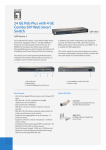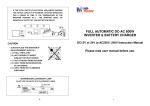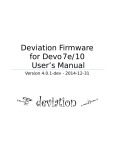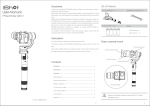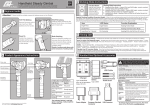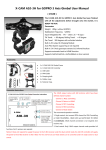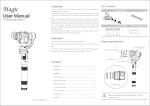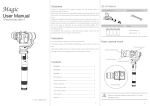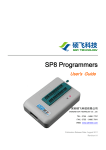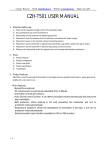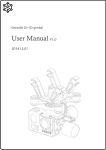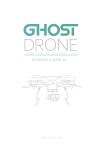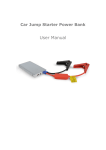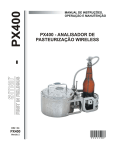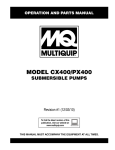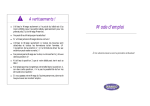Download FLYPRO PX400 User Manual
Transcript
FLYPRO PX400 User Manual Please visit the official website for multi-language version at http://www.iflypro.com -1- Table of Contents PX400 Summary............................................................... 2 1. Product Overview......................................................... 3 2. Description of PX400 Drone....................................... 4 2.1 Flight Mode.......................................................... 4 2.2 Description of Indicators from Aircraft............... 5 2.3 The Protection of Safe Flight............................... 6 2.4 Optical Flow Camera and Sonar Positioning........ 6 2.4.1 Usage Rules.................................................. 7 2.5 Automatic Adjustment Parameters..................... 7 3. Illustration of PX400 Drone Controls........................ 8 3.1 Remote Control Configuration............................ 8 3.2 Ground Station APP Layout................................. 9 3.3 Safety Precautions............................................... 9 -2- FLYPRO PX400 Summary Main Functions: Auto Follow-me Routes Flights Super Headless Mode FPV Real-time Transmission Altitude and Point Hold One-key Return and Circle Remote Control, APP Dual Control One-key to Takeoff and Landing Low Voltage Return Main parameters: Maximum Dimensions: 610 * 610 * 280 mm Weight (with battery): 2400g Maximum Takeoff Weight: 2800g Remote Control: DEVO10 Motor Type: FLYPRO 2814 Propeller Model: FLYPRO 1147 Carbon Fiber Diagonal Distance: 480 mm Battery: 22.2V 5400mAh Li-Po Ground Station Software: FLYPRO V1.0 -3- 1. Product Overview - Introduction PX400 includes the aircraft, remote control, camera gimbal, monitors and the ground station APP. The aircraft has quick and easy installation and disassembly. Users can control aircraft via remote control and achieve one-key takeoff, mode switching, follow, return functions via the APP. The user can view aircraft flight parameters in real time. Features: Superb aerodynamic design to reducing obstruction in flight; simple and stylish appearance; efficient power systems and flight time up to 25 minutes; high-precision three-axis stability augmentation camera gimbal; compatible with GOPRO4 and ensure the stability of the shot in flight. Fast assembly of camera gimbal, user-friendly installation and transportation. There are several flight modes to meet the needs of different users, in addition to having the follow-me function that always keeps the front of the aircraft to follow the mobile terminals. It can achieve low voltage and loss of signal return to ensure the safety of the flight. New generation flight control system and combined optical flow cameras with sonar positioning technology ensures the stability of the aircraft indoors and outdoors without GPS signal. -4- 2. Description of PX400 Drone 2.1 Flight Mode PX400 supports the following modes: Manual Mode:Relies entirely on the user’s handle without the aid of GPS, optical flow cameras and other sensors. The flight control system provides gesture stability. Altitude Hold Mode: Aircraft height is dependent on sonar (0.3 m - 3.5 m) and barometric sensors. Other operation is the same as manual mode. Point Hold Mode: If GPS satellite signal is more than 6 stars, GPS is used to hover with point hold mode. If the signal is less than six stars, the optical flow camera and sonar maintain hover with point hold mode. Circle Mode:One-key circling is operated using the ground station APP. Setting the radius causes the aircraft to provide a 360° shot. Return Mode:The one-key return button on the remote control causes the aircraft to self-return. An added safety feature to the return mode enables the aircraft to self-return when below critical voltage and/or the remote control signal is lost. Automatic Mode: The aircraft automatically takes off, flies and lands when the user sets a planned flight route on the APP. Super Headless Mode: The super headless mode allows beginners easily identify the direction of the aircraft and maintains aircraft control -5- when it is too far to see. Upon selecting this mode, the aircraft’s default front is faced away from home (location of takeoff), with its back closest to home. No matter of the aircraft’s location, pull back to fly the aircraft home. (Note: This mode requires GPS positioning). Please refer to the remote control function description to switch mode. 2.2 Description of Indicators from Aircraft. Red Light: Flight control system errors, red for error warning. Blue Light: No GPS signal, you can manually fly. Green Light: GPS signal is good, enables safe flight under GPS Mode. Yellow Light: If under the Manual Mode, then a sensor is faulty and requires a system restart. In Return Mode, yellow light indicates low battery voltage. Red and blue alternating: The flight control system is initializing; keep the aircraft stationary until the initialization is complete. Note: Long buzzer ringing means the power is on. Short buzzer sounds indicate that there is an error or a low voltage. -6- 2.3 The Protection of Safe Flight 1. When the voltage drops below 21.4V, the aircraft will automatically enter Return Mode. With a good GPS signal, the accuracy of this safety feature is about 1.5 meters. You can adjust posture of the aircraft upon landing. 2. Under GPS Point Hold Mode, if the GPS signal is lost and the aircraft is within the operational limits of the optical flow camera (up to 8 meters), you can automatically switch to optical flow Point Hold Mode. 3. If the signal of remote control is lost, the aircraft will automatically return home and land. 4. Altitude of the aircraft is limited to 400m when in range of major military and civilian airports. 5. Before takeoff, the aircraft will undergo a full system check to ensure all sensors are operational. Upon encountering an error, a yellow light will turn on and an error message will be displayed on the APP to allow for easy inspection. 2.4 Optical Flow Camera and Sonar Positioning In addition to GPS, you can also use optical flow camera and sonar for precise positioning. It is ideal for indoor point hold flight. Optical flow camera’s operational range can reach 8 m and the sonar’s operational limits are between 0.3 - 3.5 m (see video tutorial). -7- Note: The optical flow camera and the sonar sensor are sensitive to light intensity and floor characteristics, respectively. Inaccuracies will arise if materials are absorbing or reflecting excessive amounts of light or sound. 2.4.1 Usage Rules: Do not fly above reflective surfaces. Restrict the flight speed to allow for effective processing of image data. Following this rule ensures accurate flight movements and point holds. Ensure normal lighting conditions. Do not fly over surfaces with sound absorbing properties like carpet. Ensure the altitude is held between 0 - 5.5 m for ideal operation. Ensure the optical flow camera and the sonar sensor remain dry, clean and void of obstructions. 2.5 Automatic Adjustment Parameters The aircraft is set up with specific corresponding flight parameters. If the aircraft is damaged or if parts were replaced it may cause instability in flight. To restore stability, the flight parameters can be automatically adjusted. Refer to the video tutorials of automatic adjustment parameters. -8- 3. Illustration of PX400 Drone Controls 3.1 Remote Control Configuration Switch Mode: Mode Selection 1 Mode Selection 2 Mode Name Down Down Manual Mode Up Down Altitude Hold Mode Down Center Point Hold Mode Up Center Circle Mode Down Up Landing Mode Up Up Return Mode -9- 3.2 Ground Station APP Layout 3.3 Safety Precautions: 1. Beginners are recommended to fly in large outdoor areas with no people. Only fly indoors once confident and skilled in handling and control of the aircraft. 2. High-speed rotating carbon fiber propellers are very dangerous. Please do not remain in close vicinity with the aircraft after the motors start and ensure the aircraft flies a safe distance from other people and objects. 3. To avoid accidents, ensure you are capable of controlled manual flight before you use the indoor optical flow camera and sonar sensor. - 10 - 4. When using the optical flow camera and sonar sensor, ensure the ground is clear of obstruction and please follow the optical flow camera and sonar usage rules (refer to Section 2.4.1). Remember not to fly above a crowd. 5. Maintain throttle at 60% when switching modes during flight to prevent the rapid descent of the aircraft. - 11 -











